#Menstrual Cup for Beginners
Explore tagged Tumblr posts
Text
#about menstrual cup#inserting a menstrual cup for beginners#menstrual cup for beginners#femininehygiene#best menstrual cup
0 notes
Text

#menstrual cup#specifically like the disks which is the type I rec for beginners!#unquality blogging
3 notes
·
View notes
Text
I've seen people worried because it's uncomfortable so let me say this as someone who has trouble even using tampons:
It's so important to screen for cancer.
It doesn't take very long and most doctors will understand if you express concern and may be able to use a smaller speculum.
Like I said, it's something I also have trouble with, so I get myself a little treat when I get them done (last time I got boba!).
Cervical cancer is very serious and I want you to be around as long as possible.
Attn: People With Cervixes!

When was your last Pap smear?
Because I am tired of seeing young people (think 40 year olds!) die horribly of an almost completely preventable disease, and I haven't seen the obligatory Tumblr PSA about it, so I'm making my own.
1. CERVICAL CANCER IS REALLY BAD
Cancers that have a good prognosis are usually cancers that can be caught early--like skin cancer, which is easily seen, and therefore usually treated very early. Cervical cancer does not give you symptoms until you have very advanced disease, which means unless someone is regularly testing your cervix, you will likely not be diagnosed early. More than half of people diagnosed with cervical cancer present with advanced disease. 75% of them will be dead within 5 years. For comparison, when caught in the earliest stage, there is a 90% 5 year survival rate. Treatment for those diagnosed is chemo and radiation, and believe me, those are not fun. If you do happen to be in the lucky 25% of survivors, if your cancer comes back, you have an 85% chance of dying within a year. Also! We think of cancer as something that happens to old people, but the average age of diagnosis for cervical cancer is 50.
2. WHO GETS CERVICAL CANCER?
Cervical cancer used to be the most common cause of cancer-related death in women in America, but at this point it's basically a disease of People Without Pap Smears--developing countries, immigrants, low socioeconomic status, BIPOC, rural communities, LGBTQ, etc.
3. HOW DO PAP SMEARS SAVE YOUR LIFE?
A Pap smear is a screening test for two things: HPV, and your cervical cells. HPV is the most common sexually transmitted disease in the world. Literally half of the people in America have some strain of HPV on their body. Most HPV infections go away on their own (in people with healthy immune systems), but some strains are Very Bad, and some people are just Very Unlucky, and the HPV starts causing your cervical cells to turn cancerous. 91% of all cervical cancers are caused by HPV. So a Pap smear looks to see if your have HPV, and if so, is it one of the bad ones? And also, do you have any cancerous cells hanging about in your cervix? And! It takes 10-30 years for HPV to turn those cells into cancer, which means you have a really really long time to catch it before it becomes cancer and cut those pre-cancer cells out!
4. WHAT ABOUT THAT VACCINE?
The thing my dad said I shouldn't get because it might make me a slut. Yes! There is an HPV vaccine! You should get it! It protects you against the nine most common cancer-causing types of HPV. It's recommended starting at age 11, and you can get it up to age 45 now! (It used to be 26, but as of 2020, it's now extended.)You can get it from most primary care doctors, or from Planned Parenthood, CVS, Walgreens, etc. If you get the vaccine you still need Pap smears.
5. I HEARD YOU CAN ONLY GET THE VACCINE IF YOU'RE A VIRGIN
Fake news. While the vaccine does not treat old infections of HPV, it does prevent new ones, so while the benefits are theoretically decreased in those who have already been sexually active, it does not mean you will not benefit from having it!
6. WHO GETS PAP SMEARS?
Everyone with a cervix starting at age 21, until you lose your cervix or until you're 65. You should get them every 3-5 years (depending on your exact age and what test your doctor does).
7. BUT I GOT THE VACCINE
Nice! You still need Pap smears.
8. I HAD ONE AND IT WAS HORRIBLE/I'M SCARED OF THE EXAM
Talk to your doctor about this in advance! Good gynecologists (and other providers) will work with you to minimize discomfort as much as possible. They can use a small speculum and lots of gel, prescribe anti-anxiety medications to take in advance, and some people will even use numbing creams and/or laughing gas.
9. BUT I DON'T HAVE/CAN'T SEE A GYN
Most primary care physicians can do them! So do a lot of urgent care centers!
10. BUT I'M A LESBIAN
HPV can be transmitted through oral/genital contact, hand/genital, and even hand-to-hand-then-genital, so you still need Pap smears.
11. BUT I'M A VIRGIN/ASEXUAL
You still need Pap smears. HPV can be transmitted not just through penetrative sex, but also through oral/genital, hand/genital, and hand-to-hand-then-genital, and also 9% of cervical cancers are not caused by HPV.
12. BUT I'M A TRANSGENDER MAN
If your cervix was removed, then congrats! You do not need Pap smears. Otherwise, unfortunately, you are still at risk for cervical cancer and need to be screened.
13. BUT I'M A TRANSGENDER WOMAN
Neovaginas do not need Pap smears! Congrats! Consider getting the vaccine, though, to prevent spreading HPV to others.
14. BUT I'M A CIS-GENDERED MAN
Congrats! You do not need Pap smears! You should still consider the vaccine though, not only to prevent the spread of HPV to others, but also because HPV causes 50% of all penile cancers as well.
In summary: please please please go get your pap smear. Go get vaccinated. The spread of HPV can be prevented, and cervical cancer can be caught and treated before it even becomes cancer.
DON'T FEAR THE SMEAR
#I definitely understand the concern#but it's not that bad#and I say this as someone who can't even use a beginner menstrual cup
57K notes
·
View notes
Text
Essential Guide to Intimate Hygiene for Women
Maintaining intimate hygiene is crucial for women's overall health and well-being. Understanding the importance of intimate wash products and their role in maintaining the delicate pH balance of the vaginal area is essential. Let's explore the benefits and usage of Intimate Wash for Women, focusing on intimate hygiene and pH balance.
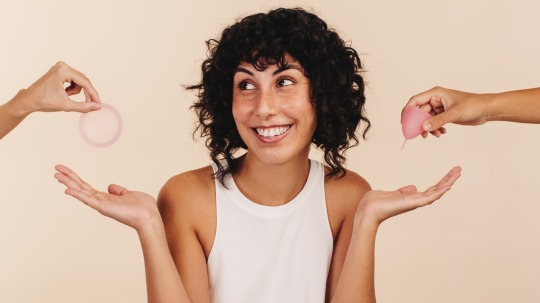
Importance of Intimate Hygiene
Intimate hygiene is essential for preventing infections, irritation, and unpleasant odors. The vaginal area is sensitive and requires special care to maintain its natural flora and pH balance. Proper hygiene practices can help in avoiding discomfort and promoting a healthy environment.
Benefits of Intimate Wash for Women
1. Gentle Cleansing: Intimate washes are formulated to gently cleanse the vaginal area without causing irritation or dryness. They are typically free from harsh chemicals and fragrances that can disrupt the natural balance.
2. pH Balance Maintenance: The vaginal area has a naturally acidic pH, usually between 3.8 and 4.5. Intimate washes are designed to maintain this pH balance, preventing the growth of harmful bacteria and yeast that can lead to infections.
3. Prevention of Infections: Using an intimate wash regularly can help prevent bacterial and fungal infections. The antimicrobial properties in these products reduce the risk of infections, keeping the area clean and healthy.
4. Odor Control: Intimate washes help in controlling unpleasant odors by eliminating bacteria that cause bad smells. This ensures a fresh and clean feeling throughout the day.
Choosing the Right Intimate Wash
When selecting an intimate wash, consider the following factors:
1. pH Balanced: Ensure the product is pH balanced to maintain the natural acidity of the vaginal area.
2. Hypoallergenic: Opt for hypoallergenic products to minimize the risk of allergic reactions and irritation.
3. Natural Ingredients: Look for washes with natural ingredients like aloe vera, tea tree oil, and chamomile, known for their soothing and antibacterial properties.
4. Fragrance-Free: Avoid products with artificial fragrances and dyes, as they can cause irritation and disrupt the natural flora.
How to Use Intimate Wash
Wet the Area: Gently wet the vaginal area with lukewarm water.
Apply a Small Amount: Take a small amount of intimate wash on your hand.
Cleanse Gently: Apply the wash to the external vaginal area and cleanse gently. Avoid inserting the product inside the vagina.
Rinse Thoroughly: Rinse the area thoroughly with lukewarm water to remove all traces of the wash.
Pat Dry: Pat the area dry with a clean, soft towel. Avoid rubbing as it can cause irritation.
Conclusion
Maintaining intimate hygiene is vital for every woman’s health. Using the right intimate wash can help keep the vaginal area clean, fresh, and free from infections. Choose a product that suits your needs, ensures pH balance, and is free from harsh chemicals. Incorporating a good intimate hygiene routine will promote overall well-being and confidence.
#intimate wash for women#best intimate wash for women#best menstruation cup brand#period menstruation cup#best menstruation cup for beginners#reusable cup menstruation#female intimate wash#menstrual cup for women
0 notes
Text
The key phases of the menstrual cycle in women
In a life cycle, a woman’s body is vulnerable to various changes. The cycle of these changes occurs in women every month, positively for pregnancy, which is called the menstrual cycle in women. When an ovum is unfertilized, the uterus lining sheds and leads to a bleeding, called menstruation.
Menarche typically occurs between the ages of 10 and 15, but it can happen earlier or later for some girls. Factors such as genetics, nutrition, and overall health can influence the timing of menarche.
Menopause, on the other hand, usually occurs around the age of 50, but the range can be from the late 40s to the early 60s. Menopause is a natural biological process marking the end of a woman’s reproductive years. It is denoted as the absence of menstrual periods for 12 consecutive months.
It’s essential to recognize the diversity in the timing of these biological events and not consider them as fixed milestones for every individual. Each person’s development and experiences can be unique.
The first day of bleeding is marked as the first day of a menstrual cycle and the period from one menstrual cycle to another can vary from 28 to 30 days.
Before discussing the different phases of the menstrual cycle in women, it is important to have a glimpse of the female reproductive system and organs involved in this cycle. They mainly include:
A pair of ovaries that store, nourish, and release ova.
Uterus (womb), where implantation of a fertilized egg takes place and the fetus develops.
Pair of the fallopian tubes connecting the ovaries and uterus.
The count of the ovum in each ovary is decided and fixed before the birth of a girl. As she reaches puberty, hormones stimulate the development and release of one ovum per month. This continues till menopause.
Phases of the Menstrual Cycle
The menstrual cycle is divided into four phases, namely:
Menstrual phase: On day 1, the uterus lining which is prepared for implantation starts to shed which lasts 3 to 5 days.
Follicular phase: In this phase, the primary follicle starts developing into a mature Graffian follicle. The endometrium also starts proliferating. The uterus starts preparation for another pregnancy.
Ovulatory phase: Mid-cycle phase, this is the phase in which ovulation takes place i.e., days 13-17. The end of the follicular phase along with the ovulation period defines the fertilization period.
Luteal phase: It is the post-ovulation phase, where the fate of the corpus luteum is decided. If fertilization occurs, pregnancy starts. If fertilization doesn’t occur, it marks the onset of another cycle.
Role of Hormones in Menstrual Cycle
The chemical messengers in our body called hormones, released by various endocrine glands are responsible for many changes in the human body. Menstruation is a slave to certain hormones. Every phase of the menstrual cycle is influenced by female hormones namely estrogen, progesterone, FSH, and LH. The variation in the level of each of these hormones decides the phase that a girl undergoes.
Follicle-stimulating hormone (FSH) and luteinizing hormone (LH) are Covered by the anterior pituitary. FSH stimulates the growth of ovarian follicles that secrete estrogen. Progesterone is secreted by the corpus luteum.
The secretion of FSH and LH gradually increases during the follicular phase. They stimulate the development of follicles and the release of estrogen from them. Estrogen stimulates the proliferation of the endometrium. The level of LH and FSH peaks in the middle of the cycle. LH induces ovulation. There is a sudden surge in LH level just before ovulation. After ovulation, the ruptured follicle develops into the corpus luteum, which secretes progesterone, hence the level of progesterone increases in the luteal phase. Progesterone is required for the maintenance of the endometrium for implantation. In the absence of fertilization, the corpus luteum regresses and the progesterone level decreases. It leads to the dissolution of the endometrium and menstrual flow occurs.
#Best Beginner Menstrual Cup#Cordless Full Body Personal Massager#pH balanced Intimate Wash for Women#Intimate wash for men#toilet seat cleaner spray
1 note
·
View note
Text
How to Choose the Best Menstrual Cup Size
Choosing the right menstrual cup wash is important to ensure proper hygiene and maintenance of your menstrual cup. Here’s a guide to help you choose the best menstrual cup wash for your needs:
Check the Ingredients:
Opt for a menstrual cup wash that is specifically formulated for cleaning menstrual cups. Look for a wash with mild, non-irritating ingredients. Avoid products with harsh chemicals, fragrances, or dyes that could potentially cause irritation.
pH-Balanced Formula:
A pH-balanced formula is essential to maintain the natural pH balance of your intimate area. Using a wash with the right pH helps prevent irritation and discomfort.
Fragrance-Free Options:
Fragrance-free options are generally recommended for intimate hygiene products. Fragrances can sometimes cause irritation, and it’s best to choose a wash that is free from artificial scents.
Antibacterial Properties:
Some menstrual cup washes come with antibacterial or antimicrobial properties. This can help ensure thorough cleaning and reduce the risk of bacterial growth on the cup between uses.
Compatibility with Menstrual Cup Material:
Ensure that the wash is compatible with the material of your menstrual cup. Most menstrual cups are made of medical-grade silicone, rubber, latex, or elastomer. The wash should be suitable for the cup material to avoid damage.
Easy to Rinse:
Choose a wash that is easy to rinse off to ensure that no residue is left on the cup after cleaning. Residue can lead to discomfort or interfere with the cup’s performance.
Allergen-Free:
Check for allergen-free formulations, especially if you have known sensitivities or allergies to certain ingredients. A hypoallergenic wash is less likely to cause adverse reactions.
Reviews and Recommendations:
Read reviews from other users to get insights into the effectiveness and user experience of a particular menstrual cup wash. Recommendations from friends or online communities can also be valuable.
Travel-Friendly:
If you’re often on the go, consider a wash that comes in travel-friendly packaging, such as a small bottle or individually wrapped wipes.
Cost-Effective:
– While it’s essential to choose a quality product, consider the cost-effectiveness of the wash. Some brands offer larger sizes or bundles that may be more economical.
Remember that it’s important to follow the manufacturer’s recommendations for cleaning and maintaining your specific menstrual cup. Regular cleaning and proper care can extend the life of your menstrual cup and help ensure a hygienic experience during your menstrual cycle. Senzicare is a right choice for all and it has antibacterial protection which keeps the cup 99.9% germs free. Senziwash menstrual cup wash is dermatologically tested and the perfect doctor’s choice.
#best menstrual cup in india#best menstrual cup in india for beginners#menstrual cup size small#menstrual cup price#best menstrual cups
0 notes
Text
Everything You Need to Know About Herbs: Yarrow
Yarrow (Achillea millefolium)
*Poisonous *Medical *Feminine
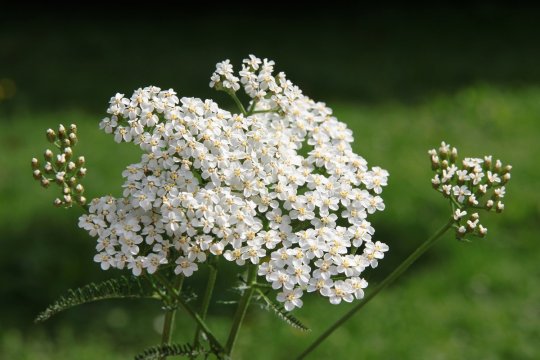
Folk Names: Achillea, Bad Man’s Plaything, Carpenter’s Weed, Death Flower, Devil’s Nettle, Eerie, Field Hops, Gearwe, Hundred Leaved Grass, Knight’s Milfoil, Knyghten, Lady’s Mantle, Milfoil, Militaris, Military Herb, Millefolium, Noble Yarrow, Nosebleed, Old Man’s Mustard, Old Man’s Pepper, Sanguinary, Seven Year’s Love, Snake’s Grass, Soldier’s Woundwort, Yarroway, Yerw
Planet: Venus, Sun
Element: Water, Air
Deities: Cernunnos, Hernes, Pan
Abilities: Courage, Love, Psychic Powers, Exorcism, Clarity, and Healing
Why Poisonous?: Contain thujone (just like Wormwood) Thujone is a chemical compound in yarrow that excites the nervous system. Causes seizures, hallucinations and other adverse reactions.
Characteristics: Has white flowers that bloom atop straight stalks with grayish-green serrated leaves that have a feather like appearance. Is a perennial plant that can grow to 3 feet.
History: Is native to Northern and Western Europe. Is famed as the wonder healer. Was used by Achilles to heal wounds, hence it’s botanical name. It is also known as nosebleed because the leaves were used to staunch blood. It was used in tea by the Native Americans for the treatment of menorrhea, the blood flow of menstruation. In the traditional Yi Jing age, the dried stalks were thrown into water to predict the future.
Growing Yarrow:
Easy to Grow? Yes
Rating: Beginner Friendly
Are the seed accessible? No
How to Grow Yarrow
Video Reference
Where to Buy Seeds
Magical Usage:
Placing the herb on top of graves help the dead peacefully crossover
Weaved into braids creates an energy web that taps into your inner wisdom
Helps develop psychic gifts
A cup of yarrow tea with a cinnamon stick can warm your bones and release hidden truths about oneself
Can be used for divination of the future and relationships
If worn on person, can stop fear and grant courage
Can be hung as a wedding decoration to guarantee seven years of a loveable marriage
Washing hair with water infused with yarrow can prevent baldness
Carrying it around can attract love, friendships, and distant connections
Exorcises evil and negativity from a person, place or thing
Medical Usage:
Clean and heal wounds
Can reduce fever
Stop internal bleeding
Lower blood pressure
Helps with menstrual issues such as: heavy bleeding, period pain, and heavy flow
In tonic form, can help with colds, flu, hay fever, weak digestion, and improve blood circulation
Sources
#witchcraft#witch community#witchblr#green witch#herbalist#medicinal herbs#occulltism#plants and herbs#nature#paganblr#witch garden#gardening#plantblr#yarrow#botany#witchcraft 101#witches#healing#witch tips#witches of tumblr#witchcraft resources#witch blog#beginner witch#herbalism
84 notes
·
View notes
Text
A Beginner's Guide to Menstrual Cups
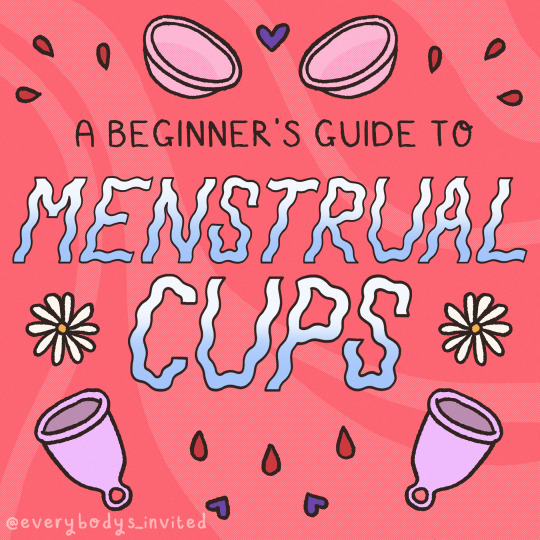
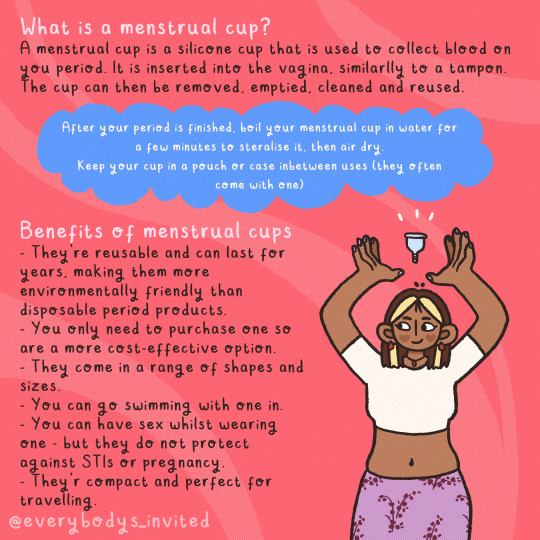
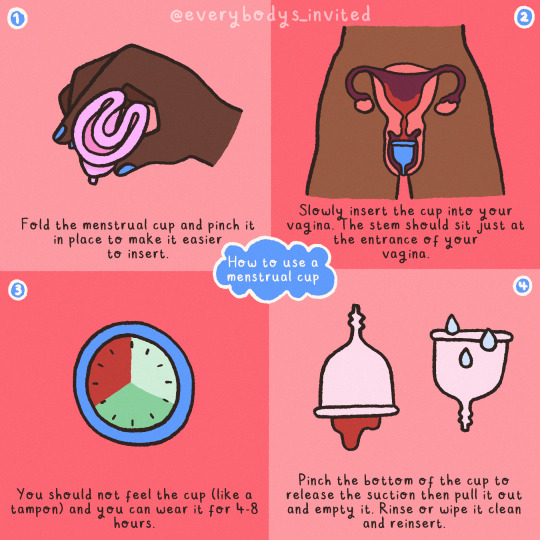
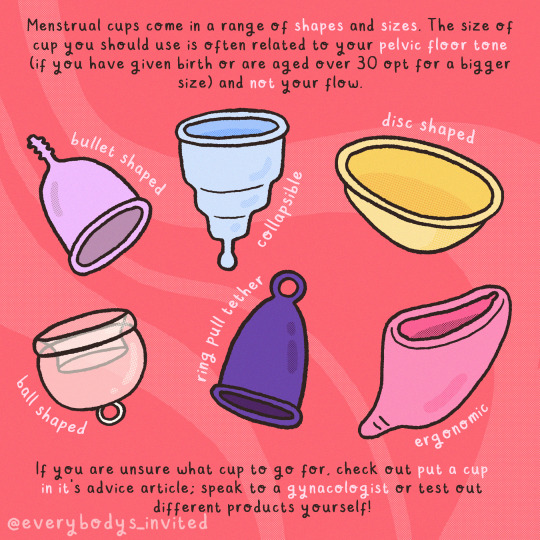
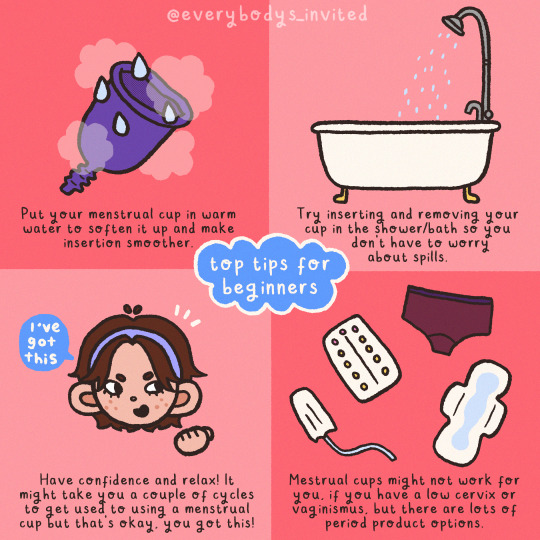
Menstrual cups are great little devices, but a lot of people are put-off from using them because they're not sure how to use one; what shape they should use, and most importantly, how to clean them! So here's a handy little guide for beginners or anyone who's curious about them and getting one!
I recommend the put a cup in it website for additional info and quiz to find which shape might work for you!✨
Menstrual cups are a great option if you're looking for a more environmentally friendly 💚 and cost-effective period product and they're reusable so you don't need to buy product every single month! They also super compact and portable so you'll never be caught off-guard when your period starts!
However it is important to note that menstrual cups aren't for everyone and that's okay, each body is different and only you know what feels right for your body. If suffer from vaginismus or another condition which made inserting things painful, a cup may not be for you.
Image & text descriptions in ALT
#education#sex education#everybodys invited#sex ed for grownups#health#self care#sex educator#menstrual cycle#menstrual health#periods#period products#image description in alt#described
14 notes
·
View notes
Note
Menstrual cup user!! Honestly once you take the time to figure it out, it's a dream to use - also cause most of them you can keep in up to 12 hours. I use the lena brand which is really great for beginners! also if you use it often, you can buy less tampons and pads, and just have them on hand for emergencies or back ups! it took me like two periods to fully get used to it :)
phew okay, i'm gonna be brave! i'm going to try it! thank you for the rec
6 notes
·
View notes
Text
ALL of my menstrual issues significantly lessened once I went full-time on washables/reusables. I use silicone cups and washable underwear/pads and I've never looked back. My cramps and flow are significantly eased. No more disgusting trash, no more foliculitus, no more spending money on new supplies. I HIGHLY recommend to all people who menatruate to make the switch, I really don't have any downsides to switching. I use Saalt brand cups, the teen and soft cup are good for beginners. I use cariona pads.
i'm curious how many people also don't experience cramps as their main symptom, because back pain is the worst for me by far it's usually how i can tell my period is coming up too
8K notes
·
View notes
Text
The Ultimate 10 best Menstrual Cup Folds Guide
Introduction:A menstrual cup is a feminine hygiene product that is used to hold the menstrual fluid during periods. As the name suggests, menstrual cups are ‘cup-shaped’ objects that are flexible enough to be inserted into the vagina. Unlike pads and tampons, menstrual cups hold the menstrual blood and do not absorb it.What is a menstrual cup fold? As menstrual cups are cup- or bell-shaped flexible objects, one needs to fold them in a certain way to make it easy for insertion and removal of the cup. When it comes to menstrual cup folds, there are various types of fold one can use to insert the cup. Although punchdown and triangle are the easiest and most popular folds, there are a lot of other types you can try.Types of menstrual folds The 10 best types of menstrual cup folds are:1. Punch-down fold Pinch the rim of one side of the menstrual cup and fold it inside the same side of the cup at the end.2. Triangle fold Hold the cup with both hands.Pinch the cup with your index and thumb fingers and flatten it.Bring the right end of the cup to the bottom of the left side to form a triangle.3. 7 fold Hold the cup with both hands.Pinch both ends of the cup with your index and thumb fingers and flatten the cup.Bring the right rim of the cup to the middle of the left side.Hold the cup between the thumb and forefinger firmly.4. C-shape fold Hold the cup and pinch the centre of the cup with your finger, forming the ‘C’ shape.5. Origami fold Hold the cup with the rim facing upward.With the other hand, press the centre of the cup to form a triangle.Fold the triangle again in half to create another smaller triangle.6. Diamond Fold Hold the cup with the index and thumb fingers firmly and press.Bring the centre part of one side of the cup to the middle region.Pinch both ends of the cup to form a circle in the top part.7. Double diamond fold Pinch the side of the top rim and fold it down, touching the centre part of the cup.Fold the left and right rims of the timer and roll them inward, making them touch each other.Fold this into half by making the left side end touch the right side end of the cup, forming a double or a half diamond.8. S fold Flatten the cup by holding it with both your index and thumb fingers and form the cup. Pinch one of the cups and place it on the other end, forming an “S” shape.9. E fold Flatten the end of the rim by holding it in between your thumb and index finger.Press it against the middle of the other end.With the other hand, press the two ends of the cup, forming an “E” shape.10. Labia fold Pinch one end of the cup with your index and thumb fingers and press it to the middle of the cup.Squeeze the sides of the cup around this.Conclusion:Folding and inserting a menstrual cup can seem hard. But with practice and patience, one can master it and make the whole process of using the menstrual cup easy and smooth.A menstrual cup is said to be better than other menstrual hygiene products, such as sanitary pads and tampons, as it is environmentally friendly and can go for 12 hours without the need to remove the cup. With these above-mentioned menstrual cup folds, you can easily find the one fold that is easy and practical for you.FAQ1. Which is the best menstrual cup fold for beginners?Although there are a lot of different types of menstrual cup folds, the most popular and easy ones are the punch-down fold and the triangle fold.2. Why is my menstrual cup not unfolding?Sometimes, menstrual cups do not tend to unfold if you are using poor technique to fold them, especially if you are a beginner. With proper technique and patience, you can make the cup unfold easily after insertion.
3. Why can't I push my menstrual cup in?Some women might find it difficult to push the menstrual cup inside. In that case, you can apply a little bit of water or lubricant gel to the rim of the cup to insert it smoothly.4. How do I make sure my menstrual cup folds?If the menstrual cup is too dry to fold, ensure to lubricate the cup with some water or a lubricant on the rims.
0 notes
Text
You know the best part about women? They are the first to suffer the radicalism of cultural changes, but they are the first to bounce back and rise from the ashes like a phoenix.
1 note
·
View note
Text
Menstrual cup beginner content pisses me off tbqh. "How do I get it out ?!" jam your fingers in there what the fuck do you want me to say.
#like im glad it's there for beginners but goddddd#like are you gonna ask me where babies come from next ?
0 notes
Text
Why Choosing the Right Sanitary Pads Matters for Every Woman
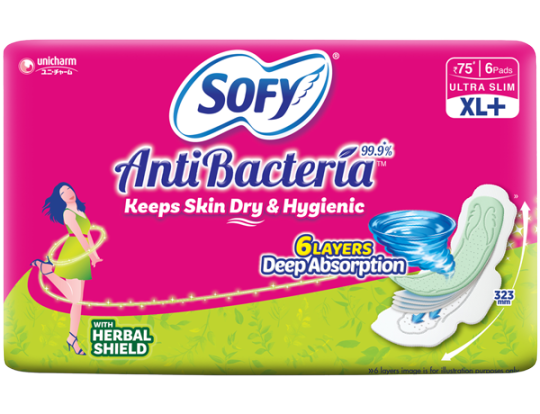
Menstruation is a natural and essential part of every woman’s life, but how it's managed makes all the difference in comfort, confidence, and hygiene. In today’s fast-paced world, women need menstrual products that adapt to their lifestyle—not the other way around. This is where high-quality sanitary pads come into the picture, offering protection, comfort, and peace of mind throughout your period.
The Undeniable Importance of the Right Sanitary Pad
Regardless of your daily routine—whether you're a student immersed in academics, a working professional balancing demanding schedules, an athlete pushing physical limits, or a dedicated homemaker—the right sanitary pad is crucial for staying fresh, active, and worry-free. While various menstrual products are available, sanitary pads remain a popular and accessible choice for many. Let’s delve deeper into why they are a go-to solution and how leading brands like Sofy are innovating to meet the evolving needs of modern women.
Understanding Sanitary Pads: Beyond Basic Absorption
Sanitary pads, also known as sanitary napkins, are absorbent products specifically designed to manage menstrual flow. Worn securely in the underwear, they come in a vast array of shapes, sizes, and absorbencies, each tailored to different body types and menstrual flow intensities.
Gone are the days of simple, bulky pads. Modern sanitary pads are sophisticated marvels of engineering, meticulously designed for superior comfort, breathability, effective odor control, and robust leak-proof protection. Innovations have transformed them into highly specialized products, featuring:
Multi-layered construction: Each layer serves a specific purpose, from a soft top sheet for comfort to an absorbent core that locks away fluid, and a leak-proof back sheet for ultimate security.
Advanced materials: Many pads now incorporate antibacterial layers to inhibit germ growth, breathable materials to reduce irritation, and odor-neutralizing technology for discreet freshness.
Specialized variants: From ultra-thin daily liners for light discharge to extra-long, highly absorbent pads designed for overnight use, and even those with enhanced wings for active movement, the variety ensures a perfect fit for every situation.
This level of innovation allows women to choose pads based on specific needs, whether it's for day-to-day wear, heavy flow days, sports activities, or undisturbed sleep.
Why Sanitary Pads Remain a Top Choice
Despite the growing popularity of menstrual cups and tampons, sanitary pads continue to be the most widely used menstrual product globally, especially in regions like India. Their enduring appeal stems from several key advantages:
1. Unmatched Ease of Use
Perhaps their most significant advantage is their simplicity. Sanitary pads are incredibly easy to use and require no internal insertion. This makes them exceptionally beginner-friendly and accessible for women of all ages, including young girls experiencing their first periods. The straightforward application process eliminates any potential discomfort or learning curve associated with internal products.
2. Superior Comfort and Comprehensive Coverage
Modern sanitary pads are engineered for maximum comfort. They are designed to conform to the body's natural contours, providing a snug yet non-restrictive fit. Brands like Sofy, with their Bodyfit and AntiBacteria pads, offer wide coverage that extends to prevent leaks from the back and sides, even during heavy flow days or active movement. The soft, cottony textures of many pads significantly reduce the likelihood of chafing and discomfort.
3. Prioritizing Hygiene and Health
Reputable brands place a strong emphasis on hygiene and health. Their sanitary pads are typically dermatologically tested, ensuring they are skin-friendly and free from harmful chemicals, dyes, or fragrances that can irritate sensitive skin. This commitment helps prevent rashes, itching, and potential infections, contributing to overall feminine health. The external nature of pads also makes it easier to monitor menstrual flow and maintain personal hygiene.
4. Extensive Variety for Every Need
The sheer variety of choices available in sanitary pads is unparalleled. Women can select from:
Daily panty liners for light discharge or as an extra layer of security.
Regular, maxi, and super pads for varying flow intensities.
Overnight pads designed with extra length and absorbency for undisturbed sleep.
Pads with wings for enhanced security and side-leak protection.
Ultra-thin pads for discreet wear.
Increasingly, reusable cloth pads for an eco-friendlier option.
This vast selection empowers women to perfectly match their menstrual product to their specific cycle, lifestyle, and comfort preferences.
Sofy: Redefining Menstrual Hygiene for Indian Women
Sofy has established itself as a leading feminine hygiene brand in India, distinguished by its commitment to innovation and user comfort. Sofy's range of sanitary pads is thoughtfully designed to address diverse needs:
Sofy AntiBacteria Pads: These pads feature a unique green antibacterial sheet that is clinically proven to kill 99.9% of bacteria, making them an ideal choice for women prioritizing advanced hygiene and prevention of potential infections during their period.
Sofy Bodyfit Pads: Engineered with a "Bodyfit" shape, these pads are designed to snugly conform to the body's curves, ensuring they stay securely in place. This innovative design significantly prevents back and side leaks, offering confidence even during high-movement activities like exercise or daily commutes.
Sofy Overnight Pads: Recognizing the need for uninterrupted sleep, Sofy offers extra-long and wide overnight pads. These provide maximum coverage and absorbency to handle heavy flow throughout the night, ensuring undisturbed and worry-free sleep.
Sofy Pantyliners: Perfect for managing light discharge, spotting, or as an additional backup when using tampons or menstrual cups, Sofy's pantyliners offer discreet, everyday freshness and protection.
Choosing the Right Sanitary Pad for You
Selecting the perfect sanitary pad is a personalized decision that depends on several crucial factors:
Flow Intensity: On days with a heavy flow, opt for pads with higher absorbency levels (e.g., "super" or "maxi" absorbency). For lighter days or spotting, a regular or thin pad will suffice.
Day vs. Night: During the day, regular or winged pads offer sufficient protection. For bedtime, always choose longer pads with wings or specific overnight options to prevent leaks while lying down.
Skin Sensitivity: If you have sensitive skin or are prone to irritation and rashes, prioritize pads with a soft, cottony top layer and those explicitly labeled as "dermatologically tested" or "hypoallergenic."
Activity Level: For busy days, workouts, or active lifestyles, select snug-fit, flexible pads that stay securely in place, like Sofy Bodyfit, which are designed to move with your body.
Sanitary Pads and the Path Towards Sustainability
The global conversation around sustainable menstruation is gaining significant momentum. While many traditional sanitary pads are disposable, the industry is evolving. Brands like Sofy are actively exploring and implementing more eco-conscious solutions, including using sustainable materials and encouraging responsible disposal methods to minimize environmental impact.
Moreover, the market has seen a notable rise in reusable cloth pads and biodegradable disposable options, offering environmentally conscious users more choices. Even with conventional disposable sanitary pads, proper disposal—wrapping them securely and placing them in designated waste bins—is crucial for maintaining hygiene and reducing their environmental footprint.
Empowering Women Through Education and Access
Beyond providing innovative products, brands like Sofy play a vital role in empowering women by actively participating in menstrual hygiene education. Through various campaigns, school programs, and awareness initiatives, they work to break down taboos and stigmas surrounding menstruation. By making high-quality sanitary pads more accessible and educating women and young girls about proper menstrual hygiene, these brands contribute significantly to improving their health, confidence, and overall well-being.
Conclusion
The selection of the right sanitary pad can profoundly transform a woman’s menstrual experience. What might otherwise be a few days of stress and discomfort can become a period of ease, confidence, and comfort. With trusted brands like Sofy, women have access to a wide array of thoughtfully designed products that cater to their unique physiological needs and daily routines. Whether you're seeking reliable everyday protection, enhanced security for active days, or complete confidence for an undisturbed night's sleep, Sofy’s extensive range of sanitary pads ensures you are comprehensively covered—both literally and figuratively.
0 notes
Text
Maintaining proper intimate Hygiene is essential for overall health and comfort. In recent years, the market has seen a surge in the availability of intimate wash products specifically formulated to cleanse the delicate area. However, a common question that arises is whether it is safe to use these products on a daily basis.
#menstrual cup for women#female intimate wash#reusable cup menstruation#best menstruation cup for beginners#period menstruation cup#best menstruation cup brand#best intimate wash for women#intimate wash for women
0 notes
Text
What Is a Period Panty and How Does It Work?

A Period Panty is a specially designed undergarment that absorbs menstrual flow without the need for traditional sanitary pads or tampons. Perfect for girls, teens, and women, it provides leak protection, comfort, and eco-conscious benefits. Whether you’re looking for everyday comfort or reusable solutions, Period Panty is changing the way menstruation is managed.
Unlike disposable products, Reusable Period Panties are washable and made from layered fabrics that wick moisture, absorb fluid, and prevent leaks. They offer a sustainable alternative and are ideal for school days, sports, or bedtime for girls and teens.
Why Are Period Panties Becoming So Popular?
Comfort and convenience are key reasons why Period Panties are trending. These innovative garments combine the security of traditional menstrual products with the ease of regular underwear.
They eliminate the bulkiness of pads and the discomfort of shifting liners, especially during long school hours or physical activity. For Period Panty users, they provide a worry-free experience that builds confidence.
Parents also love Reusable Period Panties for their eco-friendly design and long-term savings. One pair can last for years with proper care, reducing waste and repeated purchases.
How Does a Period Panty Actually Work?
A Period Panty is made of multiple fabric layers that each serve a unique purpose:
Moisture-Wicking Layer: Keeps you dry by pulling away liquid.
Absorbent Core: Holds menstrual flow securely.
Leak-Resistant Barrier: Prevents stains or accidents.
This construction ensures that Period Panty offers complete protection even on heavy flow days. Most brands offer options for light, moderate, and heavy flow, so you can pick the right type based on your period needs.
Are Period Panties Safe for Young Girls and Teens?
Absolutely. Period Panty is specifically created for beginners. They are soft, breathable, and made with gentle materials to protect sensitive skin. Girls don’t need to worry about pads moving around or discomfort during long hours at school.
Moreover, Period Panty Reusable designs are available in cute patterns and sizes to help girls feel confident and comfortable. These styles make the transition into menstruation smoother and less stressful.
Can You Wear Period Panties All Day?
Yes, Period Panties are designed to be worn for up to 8–10 hours depending on the absorbency level. Some heavy flow designs may even last overnight, which is great for stress-free sleep.
However, if you're using them on a very heavy flow day, you might want to carry a spare pair, just in case. They’re also perfect as a backup with tampons or menstrual cups.
What’s the Difference Between Pads and Period Panty?
Traditional pads stick to your underwear and often move around. In contrast, Period Panty is a built-in solution, acting as underwear and absorbent in one. They offer more freedom, better fit, and eliminate the risk of side leaks.
Plus, Reusable Period Panty saves you money in the long run. You no longer need to buy monthly supplies, and you help the planet by reducing waste.
How to Wash and Care for Reusable Period Panties
Taking care of your Period Panty is easy:
Rinse in cold water immediately after use.
Soak or hand wash with mild detergent. Avoid fabric softeners.
Air dry them instead of using a dryer to maintain fabric quality.
With proper care, your Period Panties can last up to 2 years, making them a smart and sustainable choice.
Who Should Use a Period Panty?
Period Panty is suitable for:
School-going girls
Teenagers new to periods
Active women involved in sports
Anyone looking for an eco-friendly period solution
Girls with sensitive skin who react to pads
From light spotting to full-flow days, there’s a Period Panty option for every need. And with multiple sizes and styles like Hipsters or Seamless Panty, comfort is never compromised.
Frequently Asked Questions (FAQ)
Q1. Can I wear a Period Panty without any other protection? Yes, most Period Panties are built to replace pads or tampons. For heavy flow, check the absorbency level or use as backup.
Q2. Are Reusable Period Panties hygienic? Absolutely. When washed and dried properly, they are completely safe, clean, and free from bacteria buildup.
Q3. How many pairs of Period Panties do I need? Most girls find 3–5 pairs sufficient to rotate through a full cycle, especially if washed regularly.
Q4. Can I use Period Underwear for sports or school? Yes! They’re excellent for PE classes or long school days because they stay in place and offer full coverage.
Q5. Will Period Panties smell? No. Breathable materials and moisture-wicking layers prevent odor if cleaned properly.
Final Thoughts: Why Every Girl Should Try a Period Panty
Period Panty is more than just underwear—they’re a revolutionary way to manage menstruation comfortably and sustainably. Whether you're a teen girl navigating your first period or a woman looking for eco-conscious alternatives, Period Underwear is an ideal choice.
Comfortable, leak-proof, reusable, and easy to maintain, Period Panty Reusable designs make period care worry-free. Say goodbye to disposable hassles and hello to confidence all month long.
Ready to switch to smarter period protection?Try our range of Period Panties today—because comfort and care should never be optional!
#innerwear#period panty#period panty reusable#period underwear#period underwear for girls#seamless panty
0 notes